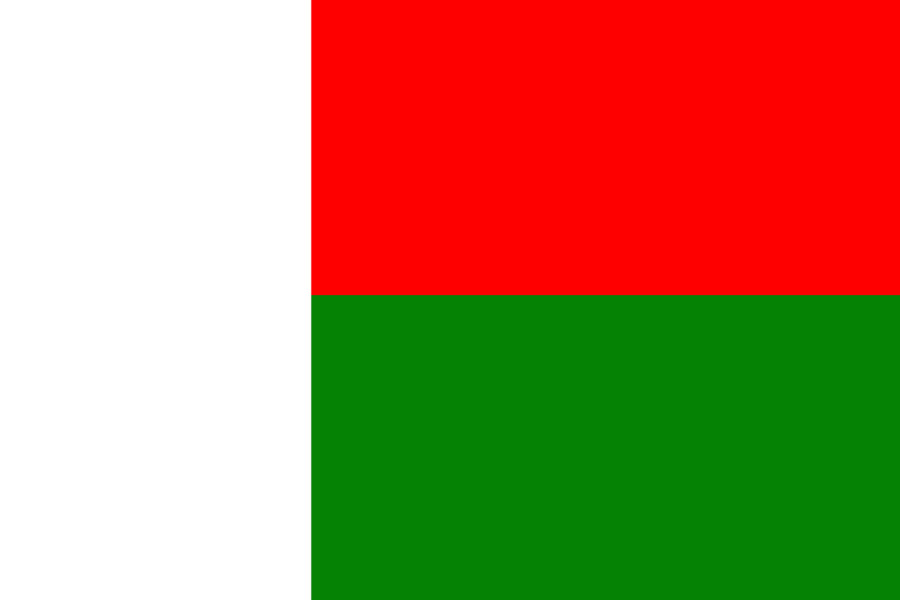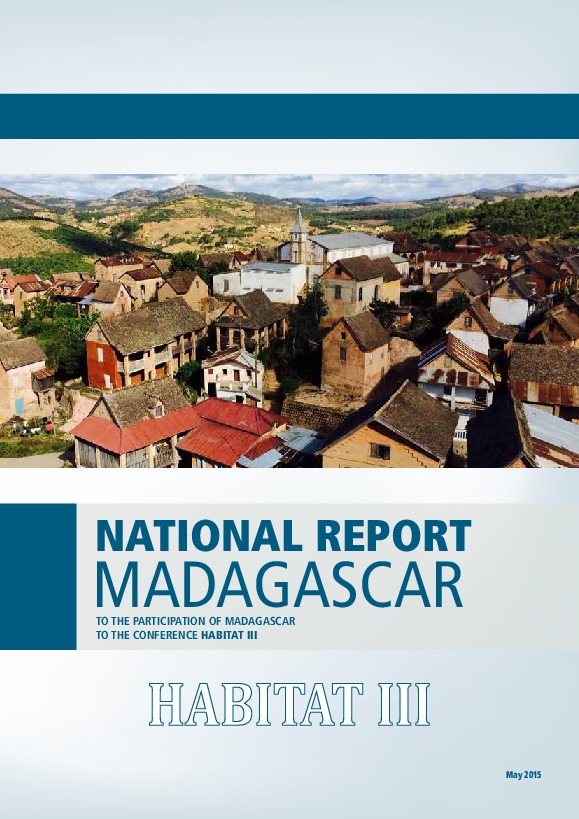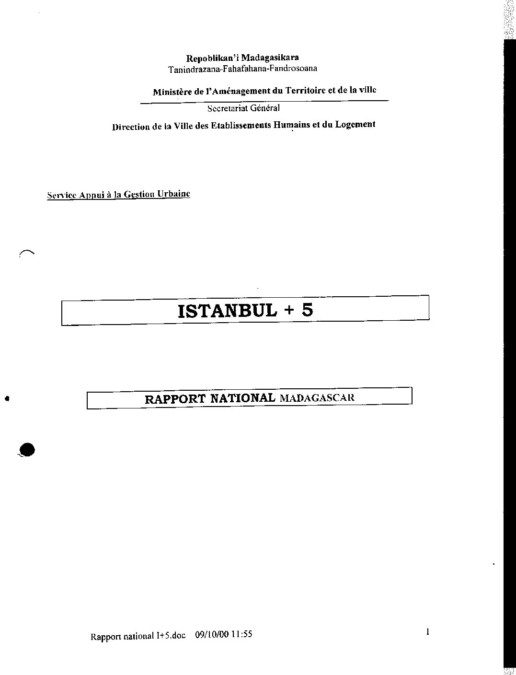
Madagascar
Urban indicators:
| Value | Year | ||
| Surface area (sq km) | 587295 | 2014 | |
| Population (proj., 000) | 24916 | 2016 | |
| Pop. density (per sq km) | 42.8 | 2016 | |
| Capital city | Antananarivo | 2015 | |
| Capital city pop. (000) | 2610 | 2015 | |
| Population growth rate (average annual %) | 2.8 | 2010-2015 | |
| Urban population growth rate (average annual %) | 4.7 | 2010-2015 | |
| CO2 emission estimates (000 tons/tons per capita) | 3077/0.2 | 2013 | |
| Population using improved drinking water sources (urban/rural, %) | 81.6/35.3 | 2015 | |
| Population using improved sanitation facilities (urban/rural, %) | 18.0/8.7 | 2015 |
| 1995 | 2005 | 2014/2015 | |
| Urban population ('000) | 3,470 | 5,270 | 8,508 |
| Level of urbanization (%) | 25.8 | 28.8 | 35.1 |
| Proportion of urban population living in slum areas (%) | 88.6 | 80.6 | 77.2 |
| Urban Slum Population ('000) | 2,997 | 4,046 | 6,273 |
| Value | Year | |
| Urban poverty headcount ratio based on national poverty lines | 51.1% | 2010 |
National Report:
National Report Executive Summary:
For five years, Madagascar was paralyzed by a political crisis. After holding the presiden-tial election in December 2013, Madagascar is starting into a new Republic. Since, the country has started to a process planning for policies and strategies for its development. And now, Mada-gascar has an official National Development Plan (PND).
By now, the vision for the country is “Madagascar, a modern and prosperous Nation”. This vision expresses the political will to work on all fronts to promote that is “strong and inclusive growth for an equitable and sustainable development of all territories”. The actions on human settlements contribute significantly to this vision. Besides that, these actions should be considered as national priorities through the National Land Use Planning Framework (SNAT), developed in 2008.
Thus, Madagascar does present its National Report in order to the Third United Nations Conference on Housing and Sustainable Urban Development HABITAT III. In response to resolution 24/14 of the UN-HABITAT Governing Council, and in line with the paragraph 11 of the General Assembly Resolution 67/126, the preparatory process of this National Report has been done with active participation of all relevant stakeholders.
A Preparatory National Committee has been implemented, and started to work on February 2013. It has been changed legally into the National Habitat Committee in November 2014. This National Committee includes stakehol-ders through central and local governments, governments’ agencies, civil society, academics institutions and private sectors. The NHC has held several meetings and workshops, to the National Report’s consultation. The preparatory process included also regional and local consul-tations, which gathered the stakeholders in all the regions of Madagascar and some represen-tative cities. Such consultations have been held in Fianarantsoa and Mahajanga in March 2015. Afterward, a specific meeting with the Partners of Habitat Agenda is held in April 2015. Finally, the National Habitat Committed and the high level decision makers in the central government have approved the National Report in May 2015.
Statistics:
Urban housing indicators
People living in slums (%)
Urban population with access to adequate housing (%)
Basic services and infrastructure
Urban population with access to safe drinking water (%)
Urban population with access to adequate sanitation (%)
Urban population with access to regular waste collection (%)
Urban population with access to clean domestic energy (%)
Urban population with access to public transport (%)
Level of effective decentralization
Policies and legislation on urban issues that local governments contributed to formulating since 1996 (%)
Share of both income and expenditure allocated to local governments from the national budget (%)
Indicators for urban policies, legislation and economy
Local authorities having implemented urban policies supportive of local economic development and creation of decent jobs and livelihoods (%)
Local authorities having adopted or implemented urban safety and security policies /strategies (%)
Local authorities having implemented plans and designs that are inclusive and respond to urban population growth adequately (%)
Share of national gross domestic product (GDP) that is produced in urban areas
Statements by Madagascar:
-
Habitat III Plenaries
Statements by other countries on behalf of African Group and G77 and China:
-
Habitat III Plenaries
-
Intersessionals: Informal Intergovernmental Meetings (May 2016)
- Statement - 18 May (by Thailand) - English Made by Thailand on Behalf of G77 and China
- Statement – 18 May (by Nigeria, 1) - English Made by Nigeria on Behalf of African Group
- Statement - 18 May (by Jamaica) - English Made by Jamaica on Behalf of G77 and China
- Statement – 18 May (by Nigeria, 2) - English Made by Nigeria on Behalf of African Group
- Statement - 19 May (by Jamaica) - English Made by Jamaica on Behalf of G77 and China
- Statement – 19 May (by Nigeria, 1) - English Made by Nigeria on Behalf of African Group
- Statement - 19 May (by Kenya) - English Made by Kenya on Behalf of G77 and China
- Statement – 19 May (by Nigeria, 2) - English Made by Nigeria on Behalf of African Group
- Statement - 20 May (by Jamaica) - English Made by Jamaica on Behalf of G77 and China
- Statement – 20 May (by Nigeria, 1) - English Made by Nigeria on Behalf of African Group
- Statement - 20 May (by Thailand) - English Made by Thailand on Behalf of G77 and China
- Statement – 20 May (by Nigeria, 2) - English Made by Nigeria on Behalf of African Group



